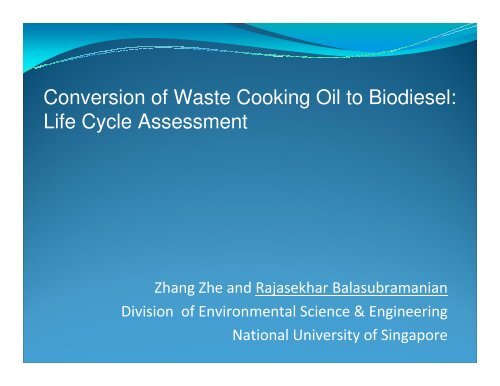Conversion of Waste Cooking Oil to Biodiesel: Life Cycle Assessment
Conversion of Waste Cooking Oil to Biodiesel: Life Cycle Assessment
Conversion of Waste Cooking Oil to Biodiesel: Life Cycle Assessment
You also want an ePaper? Increase the reach of your titles
YUMPU automatically turns print PDFs into web optimized ePapers that Google loves.
<strong>Conversion</strong> <strong>of</strong> <strong>Waste</strong> <strong>Cooking</strong> <strong>Oil</strong> <strong>to</strong> <strong>Biodiesel</strong>:<br />
<strong>Life</strong> <strong>Cycle</strong> <strong>Assessment</strong><br />
Zhang Zhe and Rajasekhar Balasubramanian<br />
Division <strong>of</strong> Environmental Science & Engineering<br />
National University <strong>of</strong> Singapore
• To compare the life cycle emission <strong>of</strong> carbon<br />
dioxide and particulate matter (PM) from<br />
biodiesel (generated from waste cooking oil) and<br />
diesel<br />
• To gain insights in<strong>to</strong><br />
biodiesel’s life cycle impacts on<br />
the environment
What is <strong>Life</strong> <strong>Cycle</strong> Analysis?<br />
• It is an investigation and evaluation <strong>of</strong> the environmental<br />
impacts <strong>of</strong> a given product caused by its existence.<br />
• It measures the whole life cycle <strong>of</strong> the<br />
product<br />
Raw Material<br />
Production<br />
Process<br />
End <strong>of</strong> <strong>Life</strong><br />
Use<br />
Phase
Importance <strong>of</strong> <strong>Life</strong> <strong>Cycle</strong> Analysis<br />
• The environmental impact generated from all<br />
the processes is analyzed, not only the<br />
manufacture or end use process<br />
• Gain overall understanding<br />
about a product’s entire<br />
environmental impact
<strong>Life</strong> <strong>Cycle</strong> <strong>of</strong> Petroleum Diesel<br />
Shipping<br />
with<br />
Ocean<br />
Tanker<br />
Emissions<br />
<strong>Life</strong> <strong>Cycle</strong> <strong>of</strong> <strong>Waste</strong> <strong>Cooking</strong> <strong>Oil</strong> <strong>Biodiesel</strong><br />
Emissions
• Process<br />
• Transesterification
Material (Adapted from the labora<strong>to</strong>ry experiment)<br />
Original waste cooking oil<br />
Methanol used<br />
KOH used<br />
<strong>Biodiesel</strong> Generated<br />
1.0638 L<br />
0.2128 L<br />
8.511 g<br />
1 L
To represent the industrial practice, the following data<br />
obtained from a research done by U.S. National <strong>Biodiesel</strong><br />
Board were used for the analysis.<br />
Energy Use<br />
Electricity<br />
0.0502 kWh<br />
Natural Gas 0.02581 m 3
Applications developed for the life cycle analysis<br />
• Entire life cycle is broken down in<strong>to</strong> different life stages <strong>of</strong><br />
the product.<br />
• Each life stage is further broken down <strong>to</strong> sub-processes.<br />
• The environmental impact from each sub-process<br />
is analyzed.<br />
• The integration <strong>of</strong> all the environmental impact is the<br />
life cycle impact.
∑ <strong>Life</strong> <strong>Cycle</strong> Emission = E i<br />
× e j<br />
• i: different life stages<br />
i<br />
• E i : the amount <strong>of</strong> sub-process used in that life<br />
stage (Unit: L, kWh, etc.)<br />
• e j : emission fac<strong>to</strong>rs associated with each sub-process<br />
(Unit: kg/L, kg/kWh)
Taking diesel as example, analysis model was used:<br />
• Stages:<br />
o Crude <strong>Oil</strong> Drilling in Middle East<br />
o Transportation <strong>to</strong> Singapore with Ocean Tankers<br />
o Refinery<br />
o Transportation <strong>to</strong> Retail Stations<br />
o End Use<br />
• Sub-processes:<br />
o Diesel, combusted in industrial boiler<br />
o Electricity, at grid<br />
o Gasoline, combusted in equipment<br />
o Natural gas, combusted in industrial boiler<br />
o Residual fuel oil, combusted in industrial boiler
All the final results are based on the same<br />
comparison basis: 1 MJ <strong>of</strong> energy that can be derived<br />
from the fuel
CO 2 emission comparison (95.27 % reduction)
1. End Use<br />
2. Refinery<br />
3. Transportation <strong>to</strong><br />
Singapore: 8000 km<br />
4. Drilling
1. Energy Use<br />
During Production<br />
2. Methanol and<br />
KOH
Only consider about production and transportation stages.<br />
58.96% Reduction
PM emission comparison (46.95% reduction)
44.60% Reduction
Used <strong>to</strong> measure the life cycle energy input (except end use phase)<br />
40.57 % reduction
<strong>Biodiesel</strong>’s (from waste<br />
cooking oil) life cycle<br />
emission <strong>of</strong> carbon dioxide<br />
and particulate matter is<br />
much lower than that from<br />
diesel<br />
The life cycle analysis indicates that the use <strong>of</strong> biodiesel as<br />
an alternative (au<strong>to</strong>motive) fuel is acceptable from the<br />
environmental point <strong>of</strong> view.
• To simulate industrial production process<br />
• To obtain first-hand data <strong>of</strong> the resource usage
Data Source: National Renewable Energy Labora<strong>to</strong>ry (NREL)<br />
Database, experiment
Other Data Sources<br />
• Saudi Arabia Emission Fac<strong>to</strong>r: CO2 Emissions from Fuel<br />
Combustion. 2009 ed, International Energy Agency<br />
• Singapore Emission Fac<strong>to</strong>r: Information on Emission<br />
Fac<strong>to</strong>rs 2010. National Energy Efficiency Committee<br />
• Emission Fac<strong>to</strong>r for KOH: Korea LCI Database<br />
Information Network. Korea Environmental Industry &<br />
Technology Institute
Cost Aspects<br />
• Most <strong>of</strong> waste cooking oil exported<br />
• Supply <strong>of</strong> WCO cannot meet the<br />
designed capacity<br />
• Currently producing with cost<br />
• Can only achieve break-even with an<br />
increase <strong>of</strong> WCO supply by 80%
<strong>Life</strong> <strong>Cycle</strong> Analysis<br />
Objectives<br />
System Boundaries<br />
Experiment <strong>to</strong> Produce <strong>Biodiesel</strong><br />
Analysis Model<br />
Results and Discussion<br />
Conclusion

















